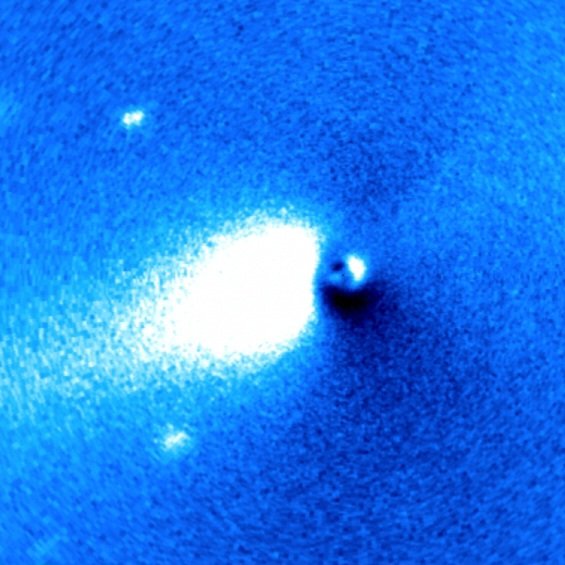Key Takeaways
- The images now tell a story that no agency can safely ignore.
- Our defense posture was built for rocks and radiation, not structured interstellar objects.
- December 19 is no longer a date on NASA’s approach chart—it’s a global checkpoint.
USA HERALD – The United States now finds itself navigating a moment unlike anything in modern astronomical history. As new, high-resolution images of 3I/ATLAS continue to emerge—the object’s behavior no longer fits comfortably inside the boundaries of known comet science. With its rapid rotation, asymmetric jets, segmented multi-million-kilometer tail, nickel-vapor anomalies, and a repeating structural envelope across multiple observation windows, 3I/ATLAS now sits at the intersection of astrophysics, national security, and planetary defense.
For years, NASA’s Planetary Defense Coordination Office (PDCO) has focused its resources on Near-Earth Objects (NEOs): asteroids, comets, and debris following predictable orbital mechanics. But an interstellar fast-rotator with internal structure, demonstrating non-gravitational acceleration and possible controlled orientation, was not in the original playbook.
Even the DART mission—America’s celebrated kinetic-impact test—was designed to redirect a known, inert rock. 3I/ATLAS is neither inert nor predictable. Its new images show something behaving in a rotational wave pattern that no natural object has displayed.
The U.S. Space Force’s Vector 2025 document, released earlier this month, lays out a blueprint for threat awareness, space-domain vigilance, and the integration of rapid-response capabilities. But Vector 2025 assumes adversarial satellites, counterspace weapons, solar-storm activity, and high-orbital debris—not an interstellar visitor whose physical morphology defies the conventional taxonomy of natural objects.
Yet the language in that document now reads with eerie relevance. General Saltzman emphasized that the Space Force must be prepared “to adapt to new phenomena that change the character of the domain.” At the time, few thought that “new phenomena” might refer to something entering the solar system from the outside.
3I/ATLAS is expected to make its closest approach on December 19, 2025, at roughly 1.8 AU from Earth—far enough to pose no direct impact threat, but close enough for the world’s best instruments to observe its true nature. The problem is no longer the distance. The problem is what the object is.
If 3I/ATLAS behaves like a typical interstellar comet, it will swing past Jupiter’s orbit and leave the solar system. But the combination of spun waves, structural symmetry, nickel-dominated spectral lines, and rapid spin cycles of minutes rather than hours has introduced a new question into the national-security conversation: what if this object has the ability to alter its own trajectory?
NASA, ESA, and the IAWN (International Asteroid Warning Network) continue to insist that all major orbital predictions remain stable. Yet these predictions assume gravitational physics applied to natural bodies. If 3I/ATLAS is expelling material in a patterned, rotational, or anisotropic way—whether natural or otherwise—its trajectory could shift unpredictably.
Non-gravitational acceleration has already been acknowledged by researchers examining its light curve and outflow jets. That means this object, unlike traditional threats, cannot be modeled solely by gravity.
The United States has spent years quietly preparing planetary-defense protocols, but these systems are fundamentally designed around known classes of risks. What 3I/ATLAS represents is something different: a domain-crossing event that blends scientific uncertainty with technical ambiguity.
Space Force radars and deep-space tracking networks are capable of monitoring spacecraft-sized objects, but interstellar visitors often move in highly eccentric, hyperbolic trajectories. Add rapid rotation, internal structure, and potential active outflow to the equation, and even the most advanced tracking systems face challenges.
Should America update its planetary-defense posture for December 19? Should we prepare emergency-response frameworks or adjust the surveillance cadence of deep-space sensors? Should Space Force allocate additional tracking time on Space Domain Awareness assets? These questions are no longer speculative. They emerge naturally from the object’s observed deviations from comet norms.
This does not imply danger. But it does demand honesty.
Planetary defense is built on probability, preparation, and transparency. No credible scientist has claimed 3I/ATLAS is artificial. But many credible scientists—including Avi Loeb—have acknowledged that its behavior demands closer examination.
If the object continues on its predicted path, it will pass Jupiter and exit the solar system. If it continues to exhibit rotation-driven non-gravitational acceleration, its outbound path could change. And if it displays further structural signatures during December’s imaging window, global agencies may need to rethink their assumptions in real time.
The next three weeks will bring the best images humanity has ever captured of an interstellar visitor whose nature remains uncertain. Whether 3I/ATLAS continues on its projected path or reveals new anomalies, America’s planetary-defense posture must be ready to adapt.
I will continue monitoring every dataset, every orbital update, and every agency-level statement as December 19 approaches. The story is far from over.



